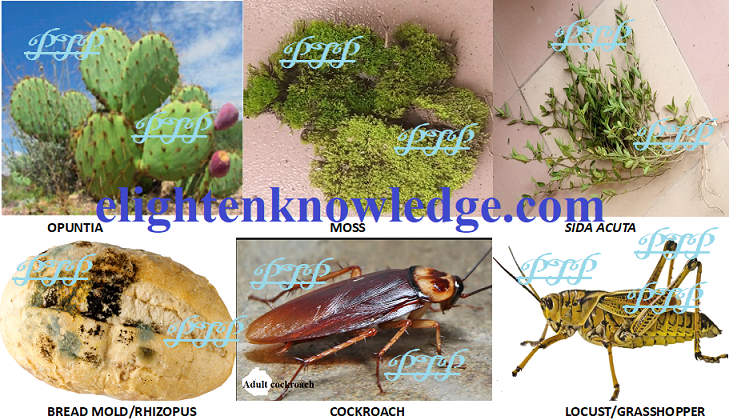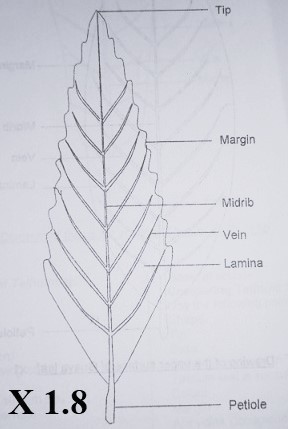Biology practical questions and answers (section 4).

Specimen A – Opuntia
State the division of specimen A.
- Specimen A – Division Angiospermophyta.
Give the habitat of specimen A with two reasons.
Habitat:
- Savanna region
- Desert/arid region
Reasons:
- Possess succulent stem to store water.
- Presence of a waxy thick cuticle to prevent excessive water loss.
- Leaves are modified/reduced into spines.
- Presence of sunken stomata to reduce the rate of transpiration.
- Stem is green (contains chlorophyll) to aid in photosynthesis.
Make a drawing 8cm – 10cm long of specimen A and label it fully.
A label drawing of specimen A

Specimen B – Moss
Specimen C – Sida acuta
Specimen D – Rhizopus (bread mold).
State the phylum/division of specimens B and D. Give two reasons in each case.
Specimen B.
Reasons:
- Have a thalloid body.
- The gametophyte is dominant.
- Presence of leaf-like whorl.
Specimen D.
Phylum Zygomycota
Reasons:
- It is non-septate
- Sporangium is borne on sporangiophore
- Zygospore is formed on the gametangia.
Give the class of specimens B and C.
- Specimen B – Class Musci
- Specimen C – Class Dicotyledoneae
Give three observable differences between specimens B and C.
Specimen B |
Specimen C |
| Have no cuticle. | Have cuticle. |
| Possess no root. | Possess root. |
| Presence of rhizoid. | Rhizoid absent. |
| Gametophyte is dominant. | Sporophyte is dominant. |
| It is small. | It is large. |
| Presence of capsule. | Capsule absent. |
| Leave absent. | Leave present. |
State three economic importance of specimen D.
- It causes food spoilage or contamination.
- It improves soil fertility through decomposition.
- Cause infections in plants.
- It also removes waste from the environment.
Give two ecological importance of specimen B.
- They serve as a source of food (they are producers).
- Source of fuel
- They also check soil erosion.
- Causes weathering which leads to soil formation.
- Source of oxygen through photosynthesis.
- They also improve the moisture content of the soil.
- Moss are also plant parasites
State how each of the following affects the growth of specimen D.
Temperature:
- Suitable temperature enhances the activities of digestive enzymes.
Moisture:
- Moisture activates the digestive enzymes to digest food (organic matter) for the specimen to absorb the end product.
Give three observable differences between specimens B and D.
Specimen B |
Specimen D |
| Green in colour | Dark-brown in colour |
| Relatively large (macroscopic) | Relatively small (microscopic) |
| Presence leaf-like structure | Leaf-like structure absent |
| Presence of capsule | Absent of capsule |
State two similarities between specimens B and D.
- Both possess rhizoids
- Presence of spores in both specimens
- No vascular tissue in both specimen
Remove one of the leaves of specimen C and make a drawing 8cm – 10cm long of its upper surface.
Drawing of the upper surface of leaf of specimen C

Specimen E – Cockroach
Specimen F – Locust/grasshopper
Name the order of specimens E and F. Give three observable features of each order.
- Specimen E – Order Dictyoptera
Observable features:
- Presence of biting mouthparts.
- Possess leathery forewings.
- Also, possess equally developed appendages.
Specimen F – Order Orthoptera.
Observable features:
- Possess chewing mouthparts.
- Possess a pair of leathery forewings.
- Presence of a pair of membranous hindwings.
- Possess a pair of long hind legs.
Name the habitat of specimens E and F.
Specimen E.
- Dark cardboard, kitchen, stores or toilets.
- Crack walls
Specimen F.
- Grassland/farm/vegetation.
Give four observable differences between specimens E and F.
Specimen E |
Specimen F |
| It is dorsoventrally flattened. | It is laterally flattened |
| Possess long antennae. | Possess short antennae |
| The head is elongated. | The head is V-shaped. |
| Brown in colour | Light brown or green in colour |
| Equally developed legs. | Longer and larger hind legs. |
| Ovipositor absent. | Possess ovipositor. |
Name four observable similarities between specimens E and F.
- Possess leathery forewings and membranous hindwings.
- Presence of chewing mouthparts.
- A pair of compound eyes.
- A pair of antennae present in both specimens
- Presence of three pair of thoracic appendages.
- Presence of spiracles.
State four economic importance of specimen F.
- Pest of crops.
- Source of food.
- Destroys vegetation.
- Vector of plant pathogens.
- It is also used as bait in fishing.
- Cause financial loss when controlling.
Make a drawing 8cm – 10cm long of the lateral view of one of the hind legs of specimen E.
Drawing of the lateral view of the hind leg of specimen E







